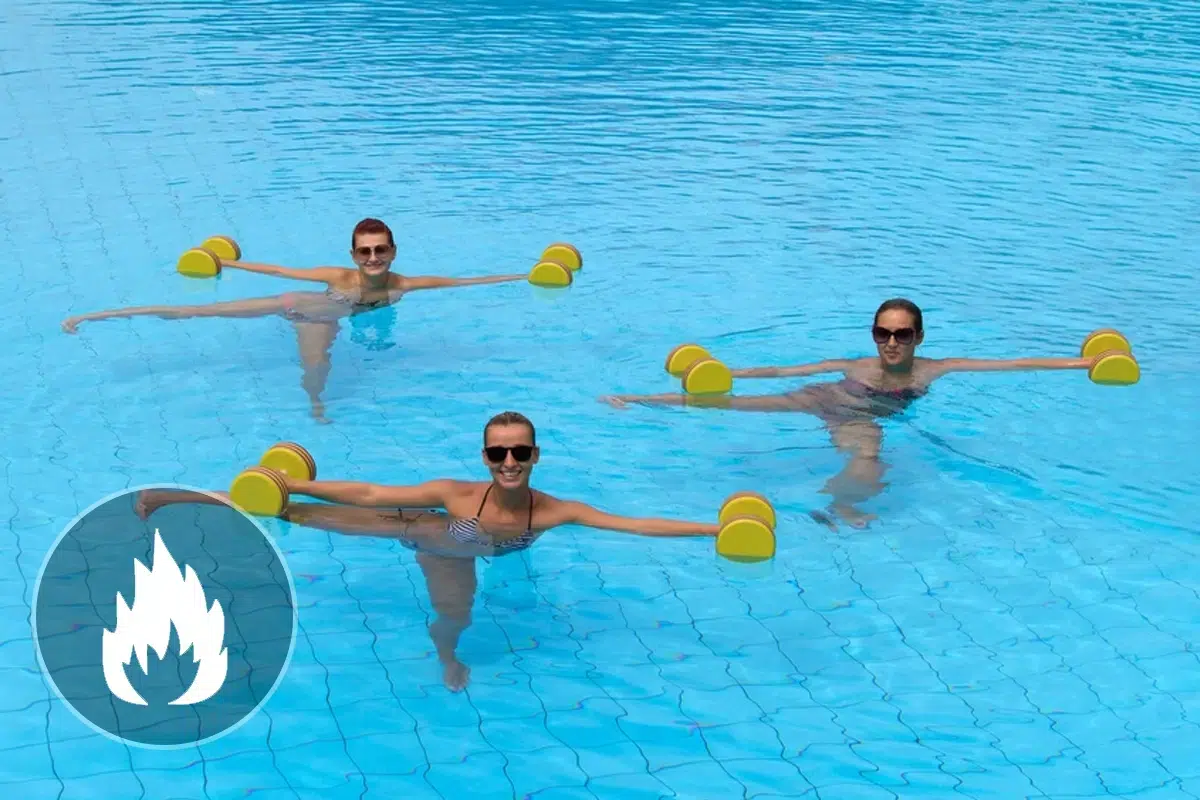Show summary Hide summary
How many calories do we burn doing aqua gym,water aerobics or aqua fitness?

Everything you need to know about aqua gym
Want to find out how many calories are burned in 30 minutes or 1 hour of aquagym? Just enter your profile to calculate your energy use. Our tool gives you the result.
Explore other REGIVIA calculators:
Aqua gym, water aerobics or aqua fitness: A few examples of energy expenditure depending on weight and activity time.
Use the table below to see how many calories you lose by doing water aerobics!
Aqua gym
Normal intensity
Expenditure in Kilocalories
| Weight | 15 minutes | 30 minutes | 1 hour |
|---|---|---|---|
| 40 kg | 42 | 84 | 168 |
| 50 kg | 53 | 105 | 210 |
| 60 kg | 63 | 126 | 252 |
| 70 kg | 74 | 147 | 294 |
| 80 kg | 84 | 168 | 336 |
| 90 kg | 95 | 189 | 378 |
See detailed calculations and metabolic equivalent for Aqua gym
Everything you need to know about aqua gym
FIND OUT MORE ABOUT AQUA GYM, WATER AEROBICS OR AQUA FITNESS
Water aerobics is a physical activity that can be enjoyed by everyone, including pregnant women. Everyone can find their own rhythm, whether gentle or invigorating.
The appeal of this sport lies in the simple fact that the body is partly supported by the water, which makes it easier to perform the movements, while the resistance of the water helps to build muscle in a harmonious way.
This sport is also ideal for effectively combating cellulite, thanks to the massaging effects of water.
Some benefits of doing aqua gym, water aerobics or aqua fitness:
- Muscle strengthening: Water offers natural resistance, so muscles can be strengthened gently and effectively. Exercises performed in the water work the muscles of the whole body, particularly the muscles of the legs, arms, abdomen and back. This helps to improve muscle strength and tone the body.
- Improved cardiovascular capacity: The movements performed in the water require a cardiovascular effort, which helps to work the cardiorespiratory system. Aqua gym helps to improve endurance and lung capacity, while promoting better blood circulation.
- Preservation of joints: Water exerts hydrostatic pressure on the body, reducing the impact on joints. This makes aquagym particularly suitable for people suffering from joint pain, osteoarthritis or mobility problems. Exercise in the water helps to preserve joints while strengthening muscles.
- Improved flexibility and balance: The resistance of the water means that movements are smoother and wider, helping to improve flexibility. The instability of the water also stimulates the stabilising muscles, helping to improve balance and coordination.
- Stress reduction and relaxation: Aqua gym gives you a feeling of lightness and relaxation in the water, which helps to reduce stress and promote deep relaxation. The aquatic environment provides a feeling of well-being and allows you to relax mentally while engaging in physical activity.
In conclusion, aqua gym is a complete sports activity that is accessible to all, offering numerous benefits for body and mind. Whether you’re looking for an activity to get back into shape, relieve joint pain or simply relax, aqua gym can be an excellent option. Don’t hesitate to try a water aerobics session supervised by a professional to discover all the benefits of this aquatic activity.
How to calculate the number of calories burned doing aqua gym, water aerobics or aqua fitness
The result displayed is expressed in Kcal and is calculated using the MET (Metabolic Equivalent of Task). The MET for each activity is the result of statistical data and cannot therefore be interpreted as an exact calculation, but rather as an estimate that takes into account the MET value and the ratio between the time spent doing an activity and the weight of the individual.
For example: The MET value for aqua aerobics is 4, which means that a person doing aqua aerobics consumes 4 times more energy than when resting. It should be noted, however, that this MET value should be moderated, as a very toned aqua gym session will be closer to 6.
MET values for different levels of aqua gym intensity
- aqua gym MET = 4
Discover the detailed formula to calculate your daily energy expenditure while doing aqua gym, water aerobics or aqua fitness
Consumption in Kcal per minute = (MET*3.5*Weight in kilos)/200
This means that for a person weighing 60 kilos doing water aerobics for 50 minutes:
Kcal consumption per minute = (4*3.5*60)/200 = 4.2 Kcal/min
So for 50 minutes = 4.2*50 = 210 kcal for 50 minutes
All sports in detail!



















































